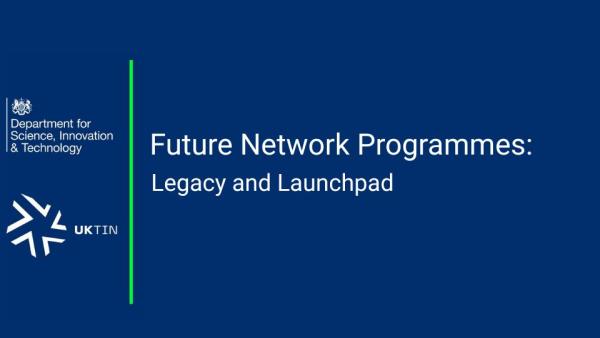
As we edge closer to the end of another fiscal year, Keith Bullock—Program Director at DCMS —reflects.
The UK's competitive economy, full of world-class talent and scientific research excellence provides a brilliant environment for progressing research and development. We’ve seen this first hand in the incredible progress from our initial projects stemming from the £250 million diversification-focused R&D programme.
Our 14 Future RAN projects are investigating new products and services to unlock the full potential of Open RAN. Our aim is to contribute to the delivery of the 5G Supply Chain Diversification Strategy's objectives of disaggregated supply chains, and open interfaces by default, with security being a priority in network deployment by providing R&D funding via competitive grants.
Already, the projects have demonstrated notable progress. A couple of weeks ago, the Best of British RAN Development Project (BoB) showcased a prototype of a new, UK-made 5G small cell (Cellxica), which creates power efficiency in a smaller form. The unit has been designed for lamp post mounting to help infill coverage and promises security, enabling safety features at each layer of the radio stack.
SmartRAN Open Network Interoperability Centre (SONIC) Labs has likewise been working at pace to develop its new Lab in the Digital Catapult offices in London, which has built upon its existing facility for long-term capability with the intention to make a lasting impact. SONIC has also designed a commercially-neutral, collaborative environment for open, disaggregated and software-centric network solutions and multi-vendor architectures, maintained and operated by Digital Catapult (DC) and Ofcom to provide testing services for suppliers; the organisation has received notable interest from other labs and governments across Europe and further afield, with a new lab launching soon. January saw us welcome Japanese State Minister Asako Omi and colleagues from the Japanese Ministry of Internal Affairs and Communications to visit the SONIC facilities, alongside executives from Japanese companies Rakuten Symphony, NEC and Toshiba.
Alongside this, we have announced the UK Telecoms Lab (UKTL), a physical lab space in the Metropolitan Borough of Solihull that will provide users with representative test networks and physical connections to federated testbeds and facilities. Creating dozens of high-skilled jobs for the region, the lab will be a mix of general access and commercially compartmentalised areas. Working with Ofcom and NCSC, the UKTL will evaluate the security of telecoms equipment and software, and test to make sure it works properly when connected to kits made by different manufacturers. We announced in December that the National Physical Laboratory has signed the contract to operate the UKTL lab on DCMS’ behalf through March 2025. As a public body, the NPL will provide the UKTL with vital independence from industry and its status as an experienced operator of government laboratories will greatly accelerate the establishment of an effective operation and realisation of the UKTL’s benefits.
In December last year, we announced the three winners of the Future Open Networks Research Challenge (FONRC). The winners included prestigious UK universities: the University of York, the University of Bristol and the University of Surrey. These universities will work with large telecom organisations to conduct R&D projects, designing telecom networks of the future, and ensuring they are always open to competition and new players. We see projects like this enabling UK-based capability to help diversify the UK telecoms industry, which in turn should enable future technologies, such as 6G, to develop faster and more efficiently. The projects are in their infancy but I am excited to see how they develop.
NeutrORAN has been testing solutions to deploy 5G networks in a cost-effective, innovative and secure way. The project has created a testbed which will look to validate architecture for a multi-operator, neutral host solution at Menai science park and Cefn Du.
On the international front, we have partnered with the Korean Institute for Information & Communication Technology Planning & Evaluation (IITP), working together on a collaborative R&D project to support the development of Open RAN technologies. Each country is funding a research consortium, both of which will work together to accelerate the development of techniques that improve power efficiency in Open RAN networks, an area the industry has highlighted as a top priority in order to facilitate widespread Open RAN adoption.
UKTIN itself kicked off in October. Building on the strong foundation of UK5G, the main aim of the network is to create an inclusive and collaborative forum for the UK telecoms innovation ecosystem, bringing together industry, government, and academia to catalyse R&D investment, cooperation, and commercialisation. The network stands ready to introduce you to the people and organisations who are working with us to help you get the most out of what the UK has to offer and the team will soon be officially launching the network, which is very exciting!
We’ve seen the initial impact of the Programme already starting to emerge, and have so far awarded over £150m of funding for R&D into Open RAN. There are high levels of positive and constructive dialogue within the industry and we have successfully mobilised funds to generate real momentum through the first stage of this programme with the market responding positively towards adopting Open RAN. A number of new firms have entered the UK or expanded their UK R&D presence since the publication of the Strategy and the announcement of our programme. Many of these have actively cited the Government’s global leadership as a reason for choosing the UK for their investment.
This has contributed to operators starting initial live trials and deployment plans. Vodafone and VMO2 have both now switched on live Open RAN trial sites as part of their UK networks, again citing the Government’s work.
We are also seeing the impacts of our actions thus far on the global stage. Our primacy has seen other governments invest significantly in Open RAN, as we build a coalition of like-minded countries to tackle this global challenge. We have signed the Prague Proposals on vendor diversity with key allies and are working together with partners in Japan, Australia, the US and the UK to present a united vision for the future of Open RAN, building on our Open RAN Principles. Our leadership has been noted and appreciated globally with a number of governments reaching out to us to tap into our experience and insight while building their own investment programmes—magnifying our influence on the world stage.
What next? We’re looking towards the next tranche of the programme to build on this momentum and to further reinforce the UK as a global centre of excellence in open telecoms networks.
There are a number of areas we’re currently considering developing interventions around including the demonstration of product/solution performance in high-density demand (HDD) or live environments; development of high-performance hardware and subcomponents; Open RAN Intelligent Controller (RIC), including x/rApp development and cross-industry skills and capability needs.
We’ve also been working closely with the industry to help shape this programme of interventions. We’ve welcomed industry feedback through a number of events we’ve held throughout the course of developing the next phase of the programme. We expect to launch the competitions for these remaining interventions in the Spring, so watch this space for more information in the coming weeks. If you haven’t done so already, I highly recommend you sign up for UKTIN as the best way to stay informed about the latest developments and engage with upcoming competitions.









